Can Solar Power Collector Reduce Heat Loss in Solar Thermal Storage System?
VerifiedAdded on 2023/04/08
|15
|3407
|431
AI Summary
This research aims to determine whether an appropriate solar power collector can reduce heat loss in a solar thermal storage system. It discusses the two common types of solar power collectors, concentrating and non-concentrating, and explores the different modes of heat loss. The study also examines the use of vacuum tube solar collectors and latent heat storage systems to minimize heat loss. The research provides insights into the effectiveness of solar power collectors in reducing heat loss in solar thermal storage systems.
Contribute Materials
Your contribution can guide someone’s learning journey. Share your
documents today.
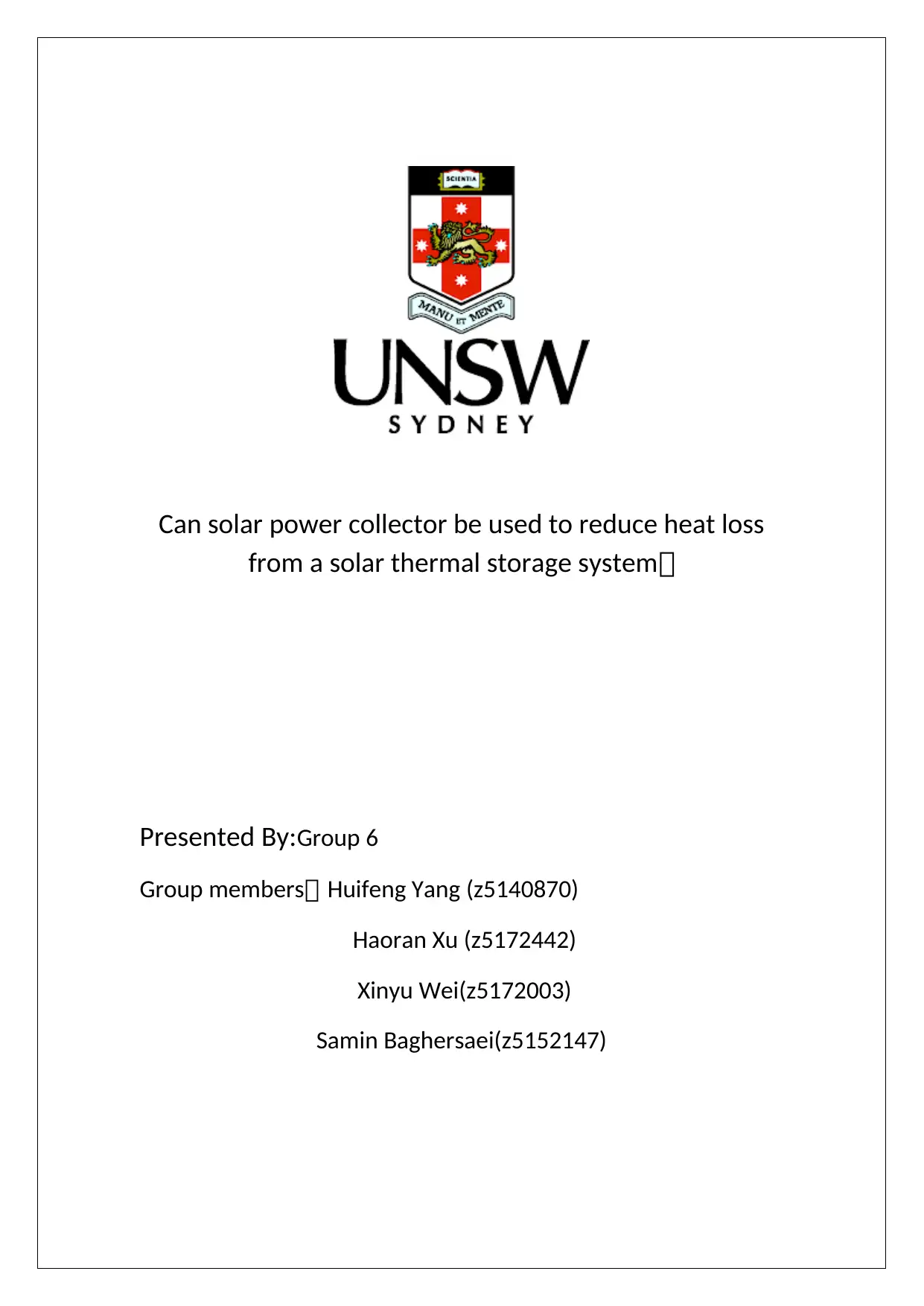
Can solar power collector be used to reduce heat loss
from a solar thermal storage system?
Presented By:Group 6
Group members? Huifeng Yang (z5140870)
Haoran Xu (z5172442)
Xinyu Wei(z5172003)
Samin Baghersaei(z5152147)
from a solar thermal storage system?
Presented By:Group 6
Group members? Huifeng Yang (z5140870)
Haoran Xu (z5172442)
Xinyu Wei(z5172003)
Samin Baghersaei(z5152147)
Secure Best Marks with AI Grader
Need help grading? Try our AI Grader for instant feedback on your assignments.
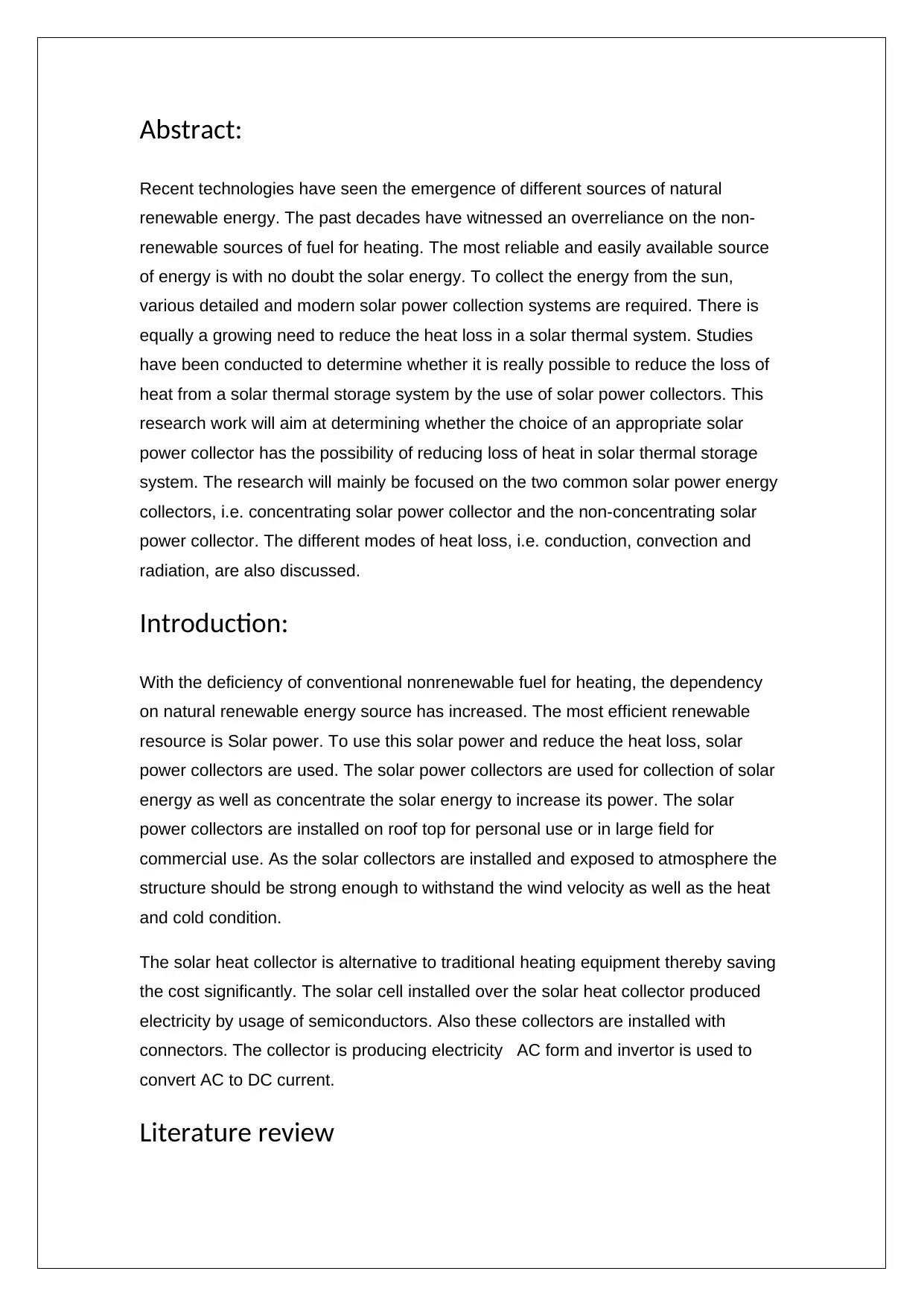
Abstract:
Recent technologies have seen the emergence of different sources of natural
renewable energy. The past decades have witnessed an overreliance on the non-
renewable sources of fuel for heating. The most reliable and easily available source
of energy is with no doubt the solar energy. To collect the energy from the sun,
various detailed and modern solar power collection systems are required. There is
equally a growing need to reduce the heat loss in a solar thermal system. Studies
have been conducted to determine whether it is really possible to reduce the loss of
heat from a solar thermal storage system by the use of solar power collectors. This
research work will aim at determining whether the choice of an appropriate solar
power collector has the possibility of reducing loss of heat in solar thermal storage
system. The research will mainly be focused on the two common solar power energy
collectors, i.e. concentrating solar power collector and the non-concentrating solar
power collector. The different modes of heat loss, i.e. conduction, convection and
radiation, are also discussed.
Introduction:
With the deficiency of conventional nonrenewable fuel for heating, the dependency
on natural renewable energy source has increased. The most efficient renewable
resource is Solar power. To use this solar power and reduce the heat loss, solar
power collectors are used. The solar power collectors are used for collection of solar
energy as well as concentrate the solar energy to increase its power. The solar
power collectors are installed on roof top for personal use or in large field for
commercial use. As the solar collectors are installed and exposed to atmosphere the
structure should be strong enough to withstand the wind velocity as well as the heat
and cold condition.
The solar heat collector is alternative to traditional heating equipment thereby saving
the cost significantly. The solar cell installed over the solar heat collector produced
electricity by usage of semiconductors. Also these collectors are installed with
connectors. The collector is producing electricity AC form and invertor is used to
convert AC to DC current.
Literature review
Recent technologies have seen the emergence of different sources of natural
renewable energy. The past decades have witnessed an overreliance on the non-
renewable sources of fuel for heating. The most reliable and easily available source
of energy is with no doubt the solar energy. To collect the energy from the sun,
various detailed and modern solar power collection systems are required. There is
equally a growing need to reduce the heat loss in a solar thermal system. Studies
have been conducted to determine whether it is really possible to reduce the loss of
heat from a solar thermal storage system by the use of solar power collectors. This
research work will aim at determining whether the choice of an appropriate solar
power collector has the possibility of reducing loss of heat in solar thermal storage
system. The research will mainly be focused on the two common solar power energy
collectors, i.e. concentrating solar power collector and the non-concentrating solar
power collector. The different modes of heat loss, i.e. conduction, convection and
radiation, are also discussed.
Introduction:
With the deficiency of conventional nonrenewable fuel for heating, the dependency
on natural renewable energy source has increased. The most efficient renewable
resource is Solar power. To use this solar power and reduce the heat loss, solar
power collectors are used. The solar power collectors are used for collection of solar
energy as well as concentrate the solar energy to increase its power. The solar
power collectors are installed on roof top for personal use or in large field for
commercial use. As the solar collectors are installed and exposed to atmosphere the
structure should be strong enough to withstand the wind velocity as well as the heat
and cold condition.
The solar heat collector is alternative to traditional heating equipment thereby saving
the cost significantly. The solar cell installed over the solar heat collector produced
electricity by usage of semiconductors. Also these collectors are installed with
connectors. The collector is producing electricity AC form and invertor is used to
convert AC to DC current.
Literature review
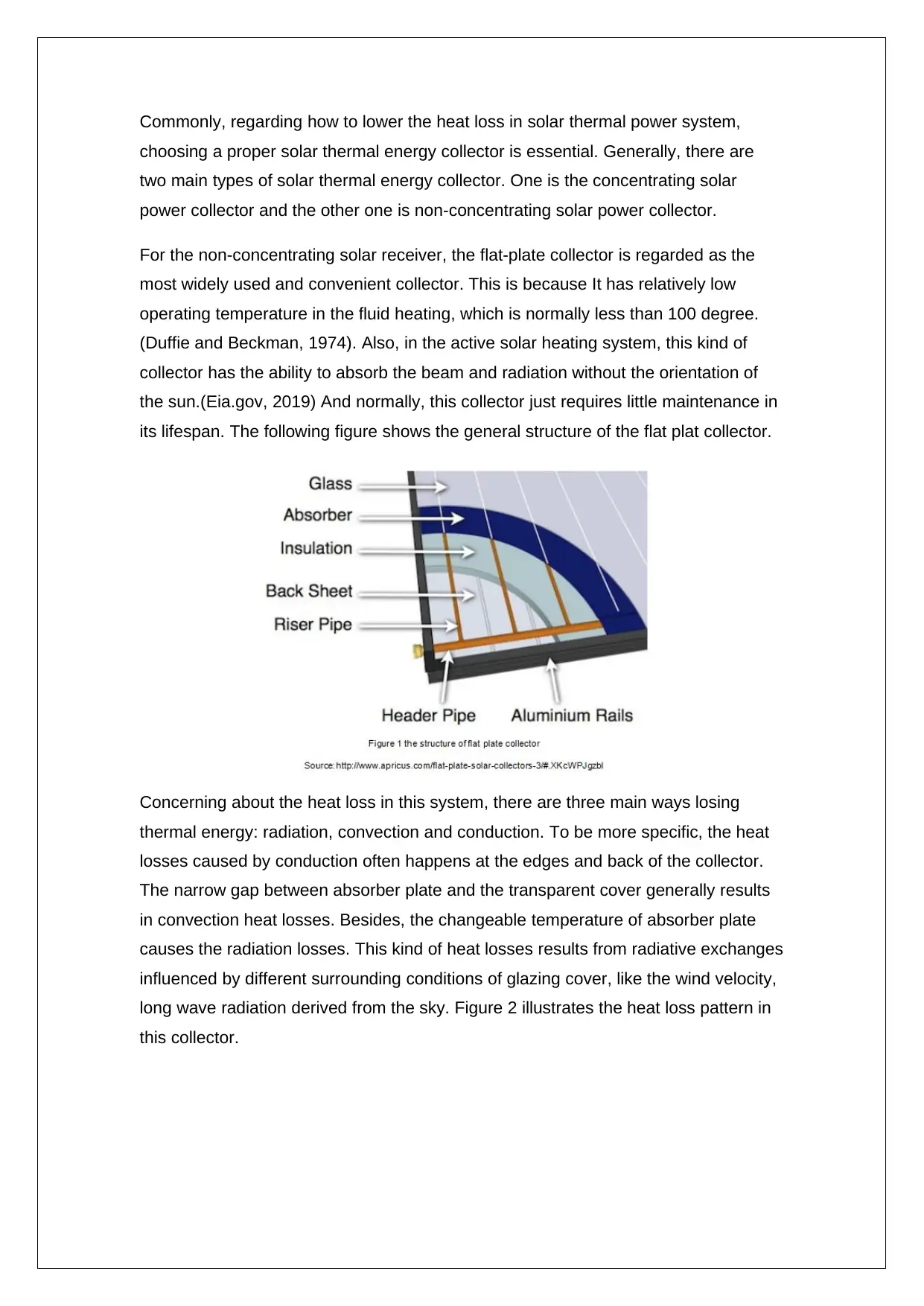
Commonly, regarding how to lower the heat loss in solar thermal power system,
choosing a proper solar thermal energy collector is essential. Generally, there are
two main types of solar thermal energy collector. One is the concentrating solar
power collector and the other one is non-concentrating solar power collector.
For the non-concentrating solar receiver, the flat-plate collector is regarded as the
most widely used and convenient collector. This is because It has relatively low
operating temperature in the fluid heating, which is normally less than 100 degree.
(Duffie and Beckman, 1974). Also, in the active solar heating system, this kind of
collector has the ability to absorb the beam and radiation without the orientation of
the sun.(Eia.gov, 2019) And normally, this collector just requires little maintenance in
its lifespan. The following figure shows the general structure of the flat plat collector.
Concerning about the heat loss in this system, there are three main ways losing
thermal energy: radiation, convection and conduction. To be more specific, the heat
losses caused by conduction often happens at the edges and back of the collector.
The narrow gap between absorber plate and the transparent cover generally results
in convection heat losses. Besides, the changeable temperature of absorber plate
causes the radiation losses. This kind of heat losses results from radiative exchanges
influenced by different surrounding conditions of glazing cover, like the wind velocity,
long wave radiation derived from the sky. Figure 2 illustrates the heat loss pattern in
this collector.
choosing a proper solar thermal energy collector is essential. Generally, there are
two main types of solar thermal energy collector. One is the concentrating solar
power collector and the other one is non-concentrating solar power collector.
For the non-concentrating solar receiver, the flat-plate collector is regarded as the
most widely used and convenient collector. This is because It has relatively low
operating temperature in the fluid heating, which is normally less than 100 degree.
(Duffie and Beckman, 1974). Also, in the active solar heating system, this kind of
collector has the ability to absorb the beam and radiation without the orientation of
the sun.(Eia.gov, 2019) And normally, this collector just requires little maintenance in
its lifespan. The following figure shows the general structure of the flat plat collector.
Concerning about the heat loss in this system, there are three main ways losing
thermal energy: radiation, convection and conduction. To be more specific, the heat
losses caused by conduction often happens at the edges and back of the collector.
The narrow gap between absorber plate and the transparent cover generally results
in convection heat losses. Besides, the changeable temperature of absorber plate
causes the radiation losses. This kind of heat losses results from radiative exchanges
influenced by different surrounding conditions of glazing cover, like the wind velocity,
long wave radiation derived from the sky. Figure 2 illustrates the heat loss pattern in
this collector.
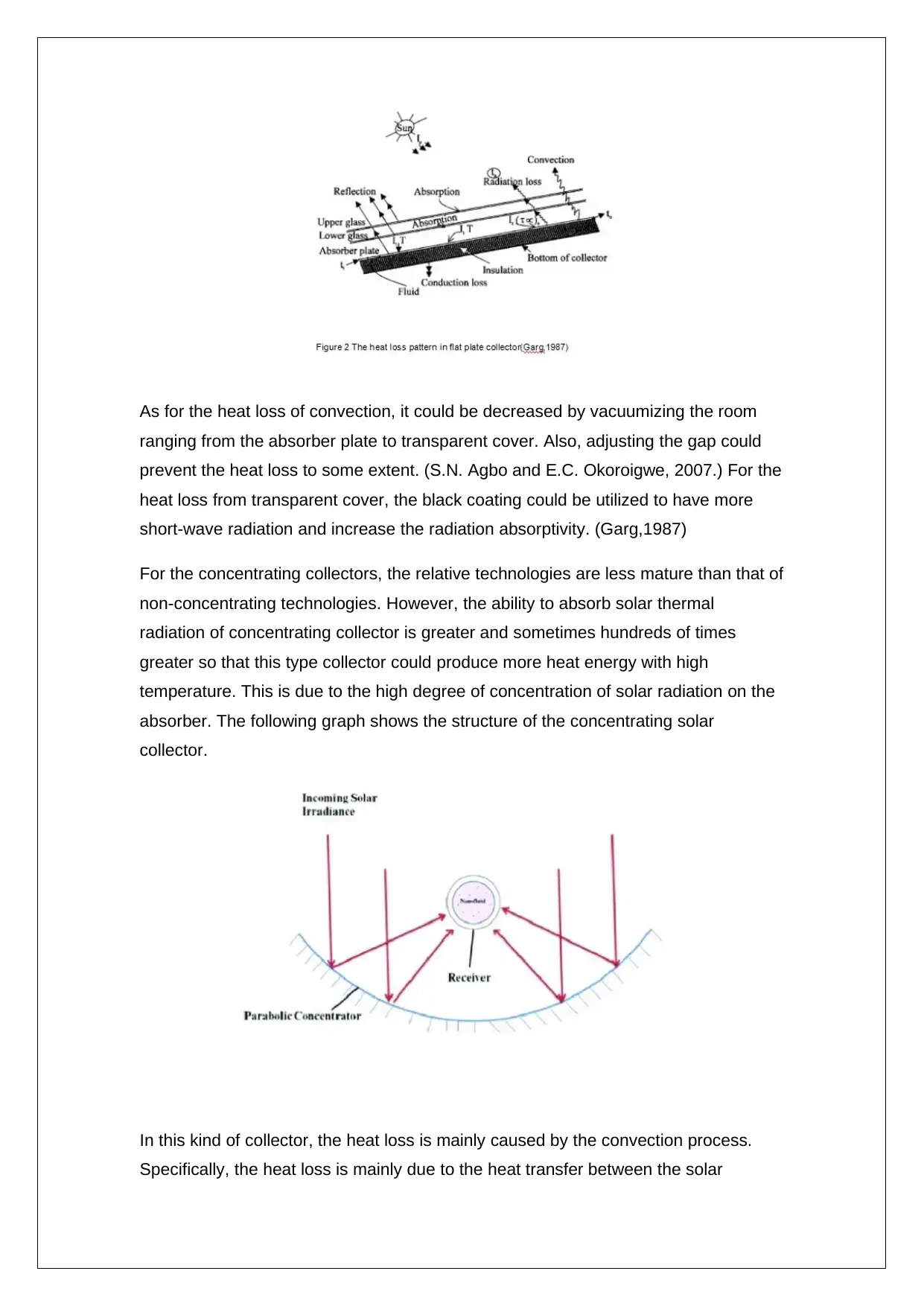
As for the heat loss of convection, it could be decreased by vacuumizing the room
ranging from the absorber plate to transparent cover. Also, adjusting the gap could
prevent the heat loss to some extent. (S.N. Agbo and E.C. Okoroigwe, 2007.) For the
heat loss from transparent cover, the black coating could be utilized to have more
short-wave radiation and increase the radiation absorptivity. (Garg,1987)
For the concentrating collectors, the relative technologies are less mature than that of
non-concentrating technologies. However, the ability to absorb solar thermal
radiation of concentrating collector is greater and sometimes hundreds of times
greater so that this type collector could produce more heat energy with high
temperature. This is due to the high degree of concentration of solar radiation on the
absorber. The following graph shows the structure of the concentrating solar
collector.
In this kind of collector, the heat loss is mainly caused by the convection process.
Specifically, the heat loss is mainly due to the heat transfer between the solar
ranging from the absorber plate to transparent cover. Also, adjusting the gap could
prevent the heat loss to some extent. (S.N. Agbo and E.C. Okoroigwe, 2007.) For the
heat loss from transparent cover, the black coating could be utilized to have more
short-wave radiation and increase the radiation absorptivity. (Garg,1987)
For the concentrating collectors, the relative technologies are less mature than that of
non-concentrating technologies. However, the ability to absorb solar thermal
radiation of concentrating collector is greater and sometimes hundreds of times
greater so that this type collector could produce more heat energy with high
temperature. This is due to the high degree of concentration of solar radiation on the
absorber. The following graph shows the structure of the concentrating solar
collector.
In this kind of collector, the heat loss is mainly caused by the convection process.
Specifically, the heat loss is mainly due to the heat transfer between the solar
Secure Best Marks with AI Grader
Need help grading? Try our AI Grader for instant feedback on your assignments.
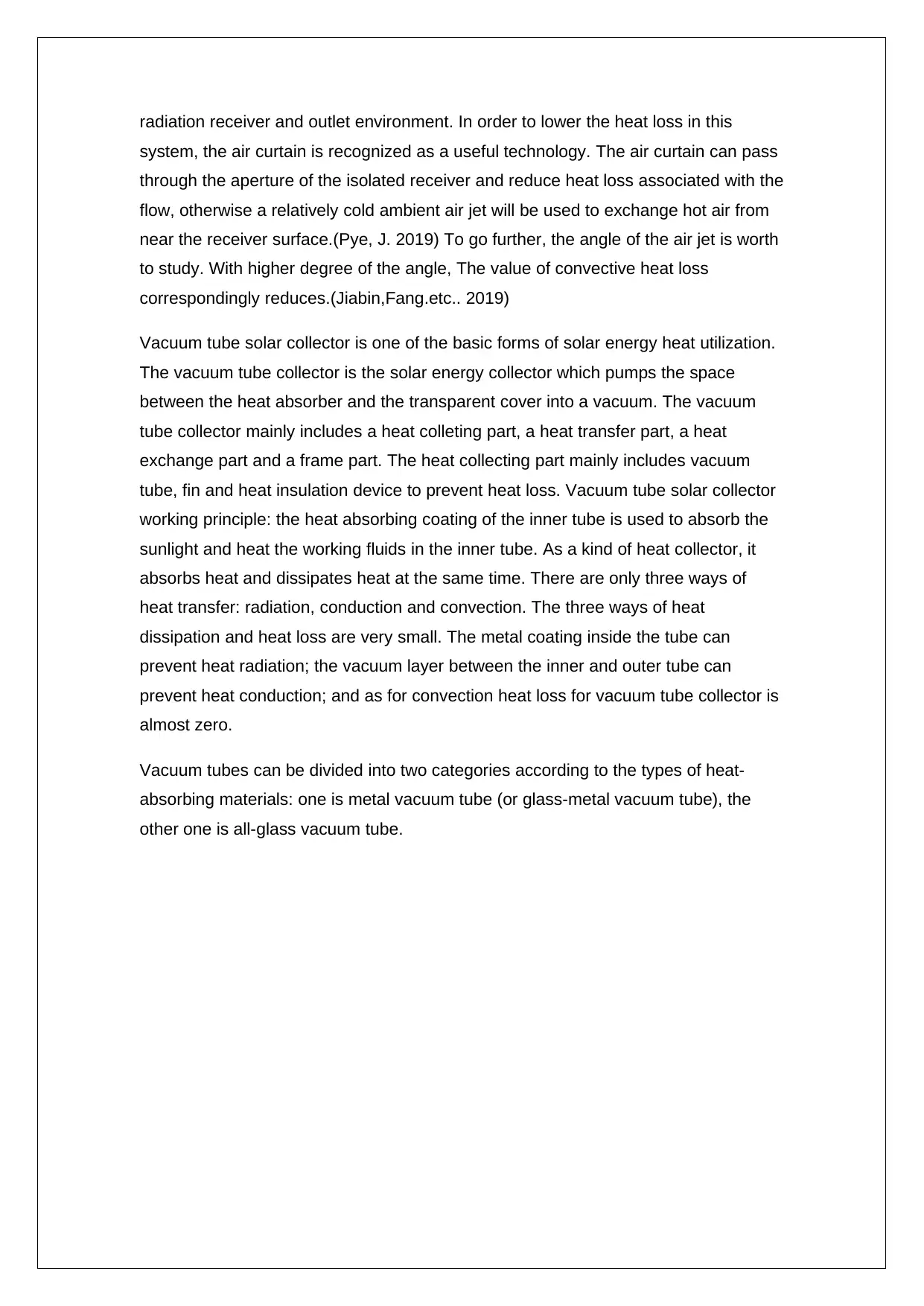
radiation receiver and outlet environment. In order to lower the heat loss in this
system, the air curtain is recognized as a useful technology. The air curtain can pass
through the aperture of the isolated receiver and reduce heat loss associated with the
flow, otherwise a relatively cold ambient air jet will be used to exchange hot air from
near the receiver surface.(Pye, J. 2019) To go further, the angle of the air jet is worth
to study. With higher degree of the angle, The value of convective heat loss
correspondingly reduces.(Jiabin,Fang.etc.. 2019)
Vacuum tube solar collector is one of the basic forms of solar energy heat utilization.
The vacuum tube collector is the solar energy collector which pumps the space
between the heat absorber and the transparent cover into a vacuum. The vacuum
tube collector mainly includes a heat colleting part, a heat transfer part, a heat
exchange part and a frame part. The heat collecting part mainly includes vacuum
tube, fin and heat insulation device to prevent heat loss. Vacuum tube solar collector
working principle: the heat absorbing coating of the inner tube is used to absorb the
sunlight and heat the working fluids in the inner tube. As a kind of heat collector, it
absorbs heat and dissipates heat at the same time. There are only three ways of
heat transfer: radiation, conduction and convection. The three ways of heat
dissipation and heat loss are very small. The metal coating inside the tube can
prevent heat radiation; the vacuum layer between the inner and outer tube can
prevent heat conduction; and as for convection heat loss for vacuum tube collector is
almost zero.
Vacuum tubes can be divided into two categories according to the types of heat-
absorbing materials: one is metal vacuum tube (or glass-metal vacuum tube), the
other one is all-glass vacuum tube.
system, the air curtain is recognized as a useful technology. The air curtain can pass
through the aperture of the isolated receiver and reduce heat loss associated with the
flow, otherwise a relatively cold ambient air jet will be used to exchange hot air from
near the receiver surface.(Pye, J. 2019) To go further, the angle of the air jet is worth
to study. With higher degree of the angle, The value of convective heat loss
correspondingly reduces.(Jiabin,Fang.etc.. 2019)
Vacuum tube solar collector is one of the basic forms of solar energy heat utilization.
The vacuum tube collector is the solar energy collector which pumps the space
between the heat absorber and the transparent cover into a vacuum. The vacuum
tube collector mainly includes a heat colleting part, a heat transfer part, a heat
exchange part and a frame part. The heat collecting part mainly includes vacuum
tube, fin and heat insulation device to prevent heat loss. Vacuum tube solar collector
working principle: the heat absorbing coating of the inner tube is used to absorb the
sunlight and heat the working fluids in the inner tube. As a kind of heat collector, it
absorbs heat and dissipates heat at the same time. There are only three ways of
heat transfer: radiation, conduction and convection. The three ways of heat
dissipation and heat loss are very small. The metal coating inside the tube can
prevent heat radiation; the vacuum layer between the inner and outer tube can
prevent heat conduction; and as for convection heat loss for vacuum tube collector is
almost zero.
Vacuum tubes can be divided into two categories according to the types of heat-
absorbing materials: one is metal vacuum tube (or glass-metal vacuum tube), the
other one is all-glass vacuum tube.
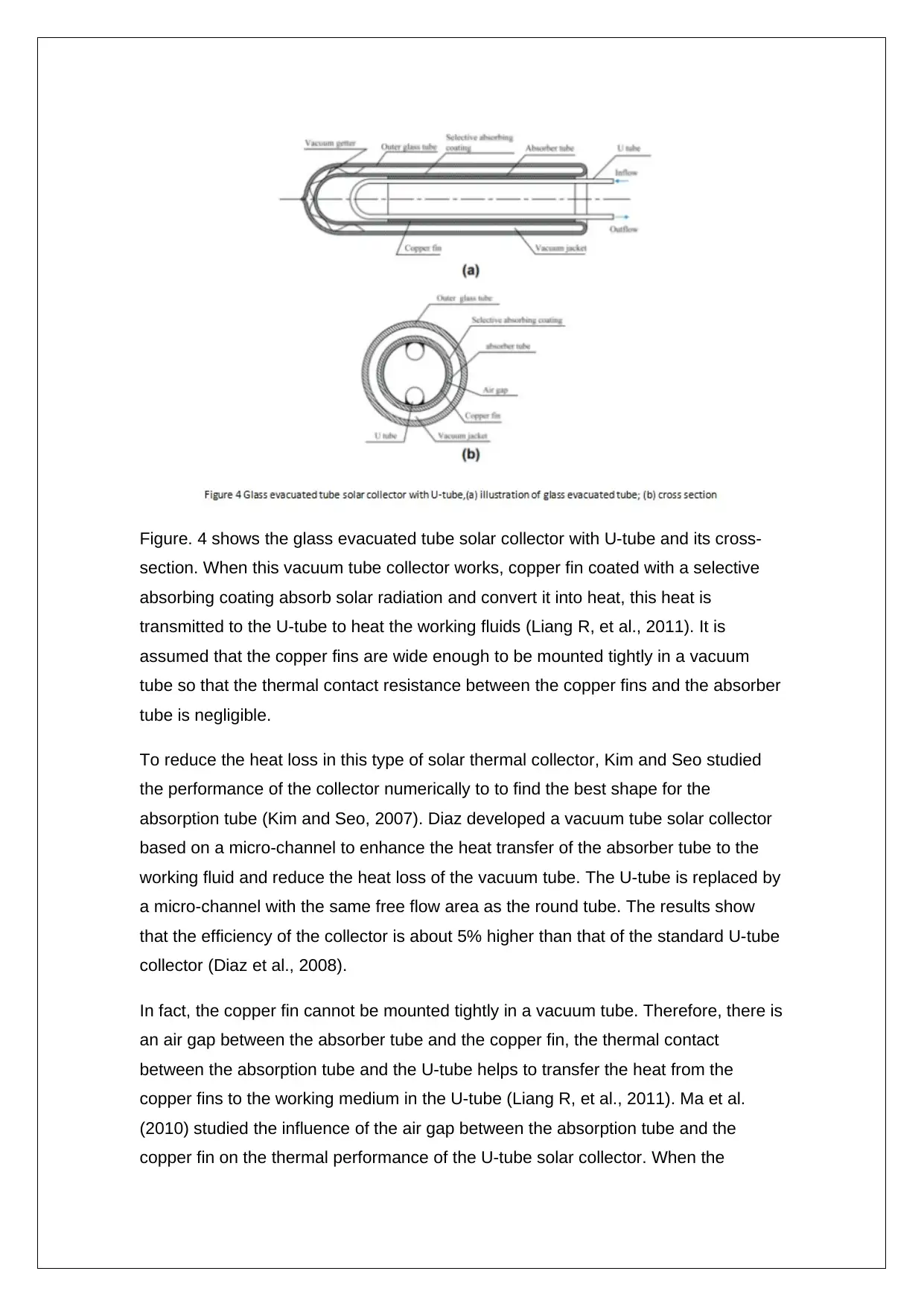
Figure. 4 shows the glass evacuated tube solar collector with U-tube and its cross-
section. When this vacuum tube collector works, copper fin coated with a selective
absorbing coating absorb solar radiation and convert it into heat, this heat is
transmitted to the U-tube to heat the working fluids (Liang R, et al., 2011). It is
assumed that the copper fins are wide enough to be mounted tightly in a vacuum
tube so that the thermal contact resistance between the copper fins and the absorber
tube is negligible.
To reduce the heat loss in this type of solar thermal collector, Kim and Seo studied
the performance of the collector numerically to to find the best shape for the
absorption tube (Kim and Seo, 2007). Diaz developed a vacuum tube solar collector
based on a micro-channel to enhance the heat transfer of the absorber tube to the
working fluid and reduce the heat loss of the vacuum tube. The U-tube is replaced by
a micro-channel with the same free flow area as the round tube. The results show
that the efficiency of the collector is about 5% higher than that of the standard U-tube
collector (Diaz et al., 2008).
In fact, the copper fin cannot be mounted tightly in a vacuum tube. Therefore, there is
an air gap between the absorber tube and the copper fin, the thermal contact
between the absorption tube and the U-tube helps to transfer the heat from the
copper fins to the working medium in the U-tube (Liang R, et al., 2011). Ma et al.
(2010) studied the influence of the air gap between the absorption tube and the
copper fin on the thermal performance of the U-tube solar collector. When the
section. When this vacuum tube collector works, copper fin coated with a selective
absorbing coating absorb solar radiation and convert it into heat, this heat is
transmitted to the U-tube to heat the working fluids (Liang R, et al., 2011). It is
assumed that the copper fins are wide enough to be mounted tightly in a vacuum
tube so that the thermal contact resistance between the copper fins and the absorber
tube is negligible.
To reduce the heat loss in this type of solar thermal collector, Kim and Seo studied
the performance of the collector numerically to to find the best shape for the
absorption tube (Kim and Seo, 2007). Diaz developed a vacuum tube solar collector
based on a micro-channel to enhance the heat transfer of the absorber tube to the
working fluid and reduce the heat loss of the vacuum tube. The U-tube is replaced by
a micro-channel with the same free flow area as the round tube. The results show
that the efficiency of the collector is about 5% higher than that of the standard U-tube
collector (Diaz et al., 2008).
In fact, the copper fin cannot be mounted tightly in a vacuum tube. Therefore, there is
an air gap between the absorber tube and the copper fin, the thermal contact
between the absorption tube and the U-tube helps to transfer the heat from the
copper fins to the working medium in the U-tube (Liang R, et al., 2011). Ma et al.
(2010) studied the influence of the air gap between the absorption tube and the
copper fin on the thermal performance of the U-tube solar collector. When the
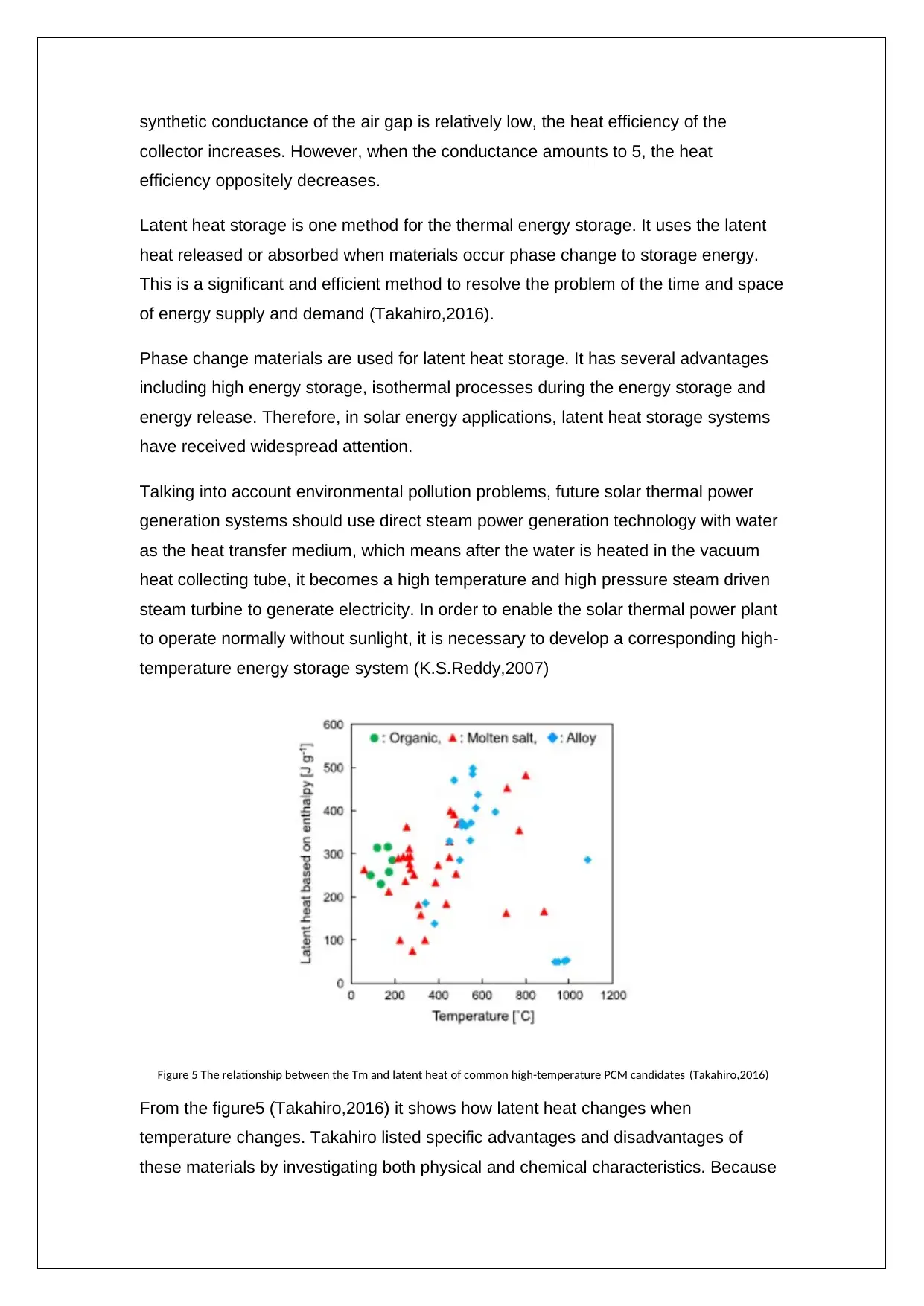
synthetic conductance of the air gap is relatively low, the heat efficiency of the
collector increases. However, when the conductance amounts to 5, the heat
efficiency oppositely decreases.
Latent heat storage is one method for the thermal energy storage. It uses the latent
heat released or absorbed when materials occur phase change to storage energy.
This is a significant and efficient method to resolve the problem of the time and space
of energy supply and demand (Takahiro,2016).
Phase change materials are used for latent heat storage. It has several advantages
including high energy storage, isothermal processes during the energy storage and
energy release. Therefore, in solar energy applications, latent heat storage systems
have received widespread attention.
Talking into account environmental pollution problems, future solar thermal power
generation systems should use direct steam power generation technology with water
as the heat transfer medium, which means after the water is heated in the vacuum
heat collecting tube, it becomes a high temperature and high pressure steam driven
steam turbine to generate electricity. In order to enable the solar thermal power plant
to operate normally without sunlight, it is necessary to develop a corresponding high-
temperature energy storage system (K.S.Reddy,2007)
Figure 5 The relationship between the Tm and latent heat of common high-temperature PCM candidates (Takahiro,2016)
From the figure5 (Takahiro,2016) it shows how latent heat changes when
temperature changes. Takahiro listed specific advantages and disadvantages of
these materials by investigating both physical and chemical characteristics. Because
collector increases. However, when the conductance amounts to 5, the heat
efficiency oppositely decreases.
Latent heat storage is one method for the thermal energy storage. It uses the latent
heat released or absorbed when materials occur phase change to storage energy.
This is a significant and efficient method to resolve the problem of the time and space
of energy supply and demand (Takahiro,2016).
Phase change materials are used for latent heat storage. It has several advantages
including high energy storage, isothermal processes during the energy storage and
energy release. Therefore, in solar energy applications, latent heat storage systems
have received widespread attention.
Talking into account environmental pollution problems, future solar thermal power
generation systems should use direct steam power generation technology with water
as the heat transfer medium, which means after the water is heated in the vacuum
heat collecting tube, it becomes a high temperature and high pressure steam driven
steam turbine to generate electricity. In order to enable the solar thermal power plant
to operate normally without sunlight, it is necessary to develop a corresponding high-
temperature energy storage system (K.S.Reddy,2007)
Figure 5 The relationship between the Tm and latent heat of common high-temperature PCM candidates (Takahiro,2016)
From the figure5 (Takahiro,2016) it shows how latent heat changes when
temperature changes. Takahiro listed specific advantages and disadvantages of
these materials by investigating both physical and chemical characteristics. Because
Paraphrase This Document
Need a fresh take? Get an instant paraphrase of this document with our AI Paraphraser
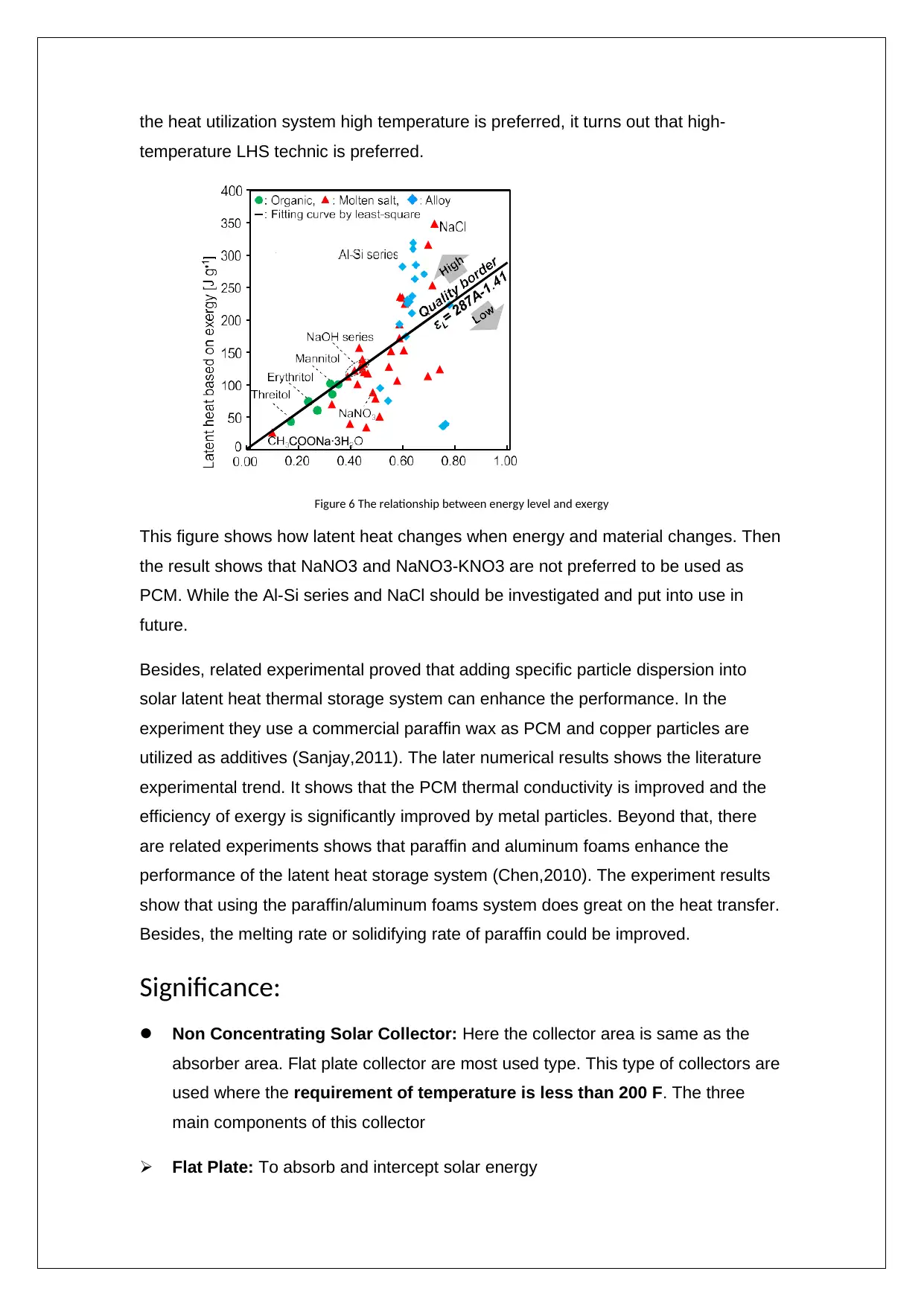
the heat utilization system high temperature is preferred, it turns out that high-
temperature LHS technic is preferred.
Figure 6 The relationship between energy level and exergy
This figure shows how latent heat changes when energy and material changes. Then
the result shows that NaNO3 and NaNO3-KNO3 are not preferred to be used as
PCM. While the Al-Si series and NaCl should be investigated and put into use in
future.
Besides, related experimental proved that adding specific particle dispersion into
solar latent heat thermal storage system can enhance the performance. In the
experiment they use a commercial paraffin wax as PCM and copper particles are
utilized as additives (Sanjay,2011). The later numerical results shows the literature
experimental trend. It shows that the PCM thermal conductivity is improved and the
efficiency of exergy is significantly improved by metal particles. Beyond that, there
are related experiments shows that paraffin and aluminum foams enhance the
performance of the latent heat storage system (Chen,2010). The experiment results
show that using the paraffin/aluminum foams system does great on the heat transfer.
Besides, the melting rate or solidifying rate of paraffin could be improved.
Significance:
Non Concentrating Solar Collector: Here the collector area is same as the
absorber area. Flat plate collector are most used type. This type of collectors are
used where the requirement of temperature is less than 200 F. The three
main components of this collector
Flat Plate: To absorb and intercept solar energy
temperature LHS technic is preferred.
Figure 6 The relationship between energy level and exergy
This figure shows how latent heat changes when energy and material changes. Then
the result shows that NaNO3 and NaNO3-KNO3 are not preferred to be used as
PCM. While the Al-Si series and NaCl should be investigated and put into use in
future.
Besides, related experimental proved that adding specific particle dispersion into
solar latent heat thermal storage system can enhance the performance. In the
experiment they use a commercial paraffin wax as PCM and copper particles are
utilized as additives (Sanjay,2011). The later numerical results shows the literature
experimental trend. It shows that the PCM thermal conductivity is improved and the
efficiency of exergy is significantly improved by metal particles. Beyond that, there
are related experiments shows that paraffin and aluminum foams enhance the
performance of the latent heat storage system (Chen,2010). The experiment results
show that using the paraffin/aluminum foams system does great on the heat transfer.
Besides, the melting rate or solidifying rate of paraffin could be improved.
Significance:
Non Concentrating Solar Collector: Here the collector area is same as the
absorber area. Flat plate collector are most used type. This type of collectors are
used where the requirement of temperature is less than 200 F. The three
main components of this collector
Flat Plate: To absorb and intercept solar energy
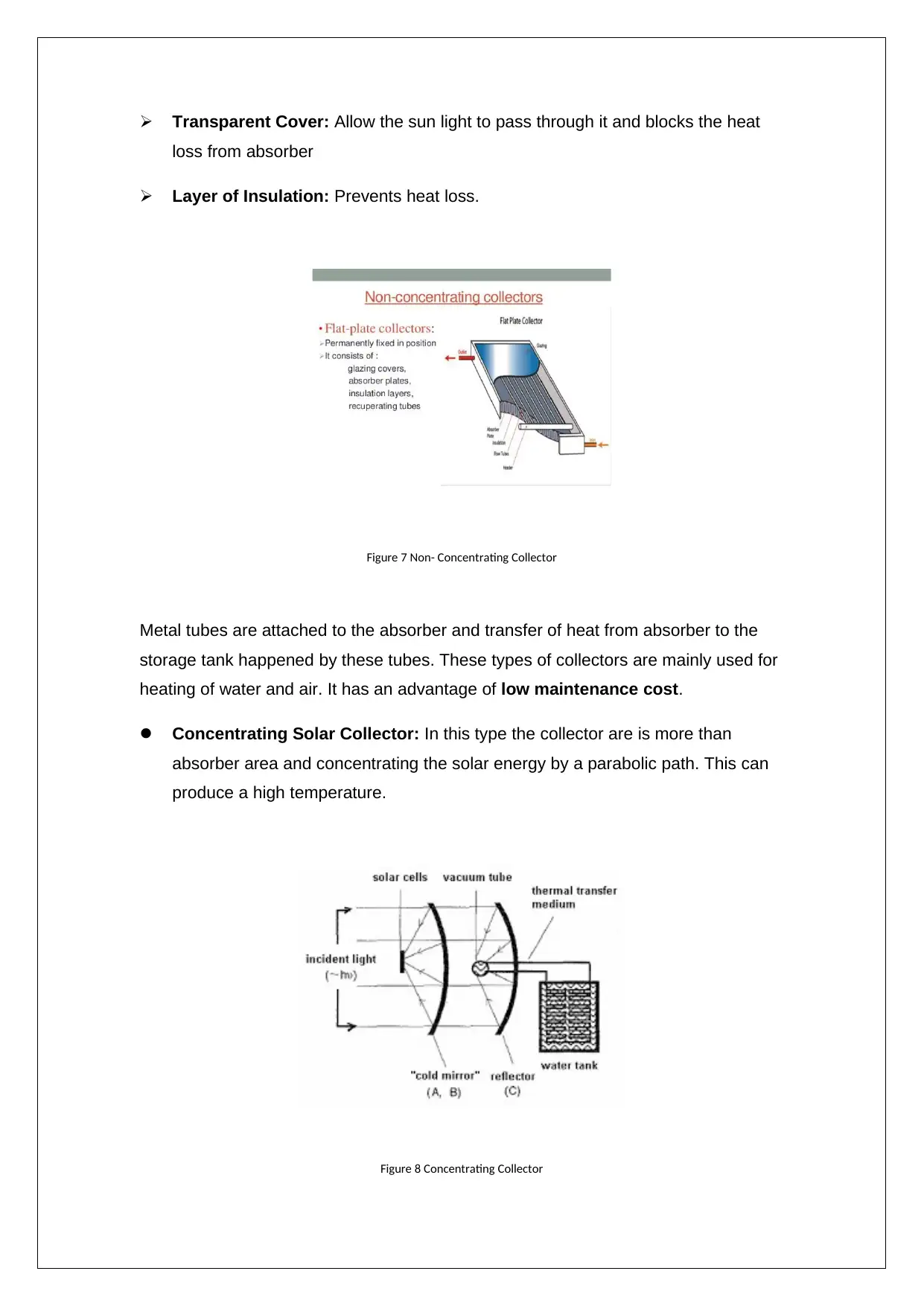
Transparent Cover: Allow the sun light to pass through it and blocks the heat
loss from absorber
Layer of Insulation: Prevents heat loss.
Figure 7 Non- Concentrating Collector
Metal tubes are attached to the absorber and transfer of heat from absorber to the
storage tank happened by these tubes. These types of collectors are mainly used for
heating of water and air. It has an advantage of low maintenance cost.
Concentrating Solar Collector: In this type the collector are is more than
absorber area and concentrating the solar energy by a parabolic path. This can
produce a high temperature.
Figure 8 Concentrating Collector
loss from absorber
Layer of Insulation: Prevents heat loss.
Figure 7 Non- Concentrating Collector
Metal tubes are attached to the absorber and transfer of heat from absorber to the
storage tank happened by these tubes. These types of collectors are mainly used for
heating of water and air. It has an advantage of low maintenance cost.
Concentrating Solar Collector: In this type the collector are is more than
absorber area and concentrating the solar energy by a parabolic path. This can
produce a high temperature.
Figure 8 Concentrating Collector
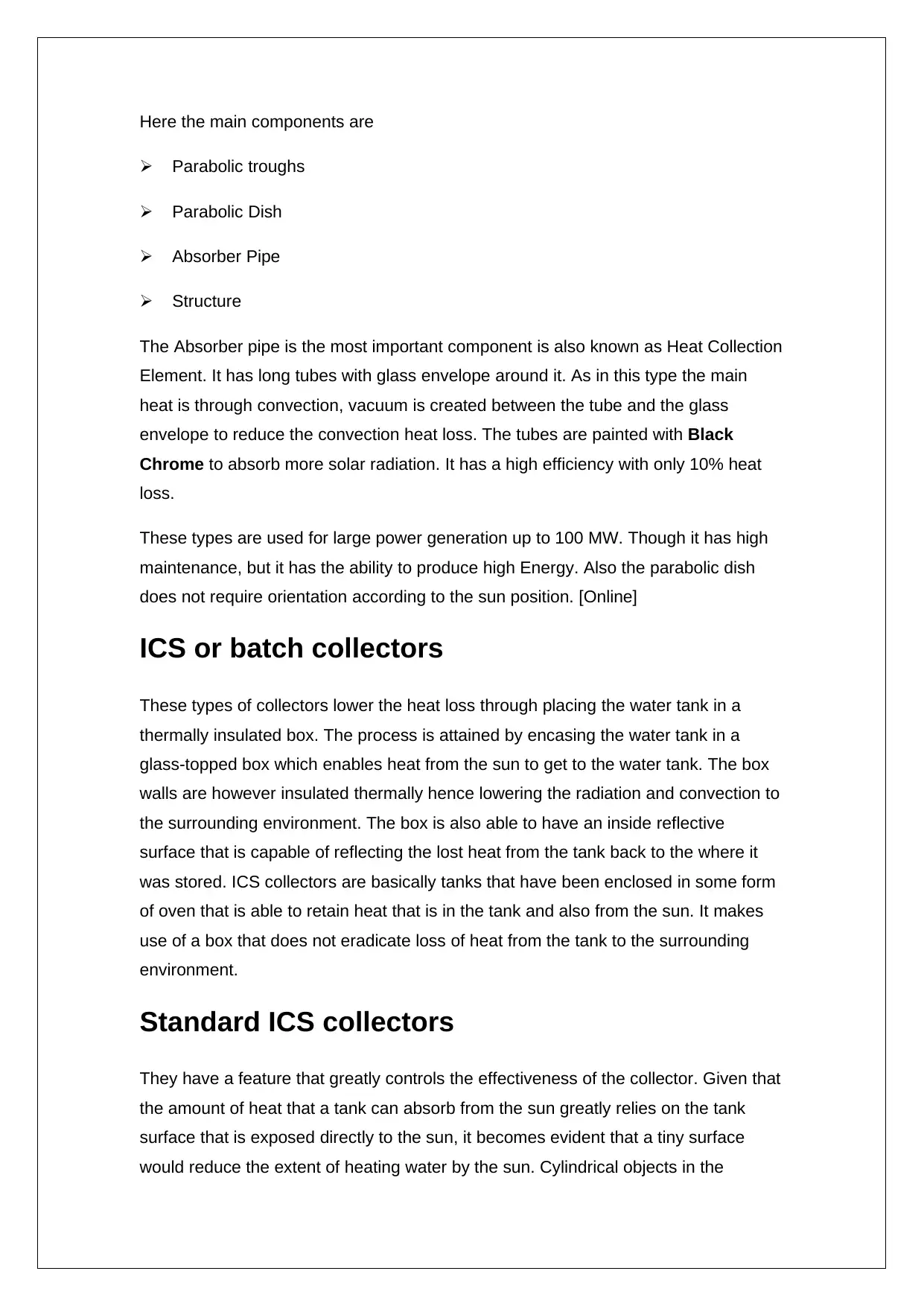
Here the main components are
Parabolic troughs
Parabolic Dish
Absorber Pipe
Structure
The Absorber pipe is the most important component is also known as Heat Collection
Element. It has long tubes with glass envelope around it. As in this type the main
heat is through convection, vacuum is created between the tube and the glass
envelope to reduce the convection heat loss. The tubes are painted with Black
Chrome to absorb more solar radiation. It has a high efficiency with only 10% heat
loss.
These types are used for large power generation up to 100 MW. Though it has high
maintenance, but it has the ability to produce high Energy. Also the parabolic dish
does not require orientation according to the sun position. [Online]
ICS or batch collectors
These types of collectors lower the heat loss through placing the water tank in a
thermally insulated box. The process is attained by encasing the water tank in a
glass-topped box which enables heat from the sun to get to the water tank. The box
walls are however insulated thermally hence lowering the radiation and convection to
the surrounding environment. The box is also able to have an inside reflective
surface that is capable of reflecting the lost heat from the tank back to the where it
was stored. ICS collectors are basically tanks that have been enclosed in some form
of oven that is able to retain heat that is in the tank and also from the sun. It makes
use of a box that does not eradicate loss of heat from the tank to the surrounding
environment.
Standard ICS collectors
They have a feature that greatly controls the effectiveness of the collector. Given that
the amount of heat that a tank can absorb from the sun greatly relies on the tank
surface that is exposed directly to the sun, it becomes evident that a tiny surface
would reduce the extent of heating water by the sun. Cylindrical objects in the
Parabolic troughs
Parabolic Dish
Absorber Pipe
Structure
The Absorber pipe is the most important component is also known as Heat Collection
Element. It has long tubes with glass envelope around it. As in this type the main
heat is through convection, vacuum is created between the tube and the glass
envelope to reduce the convection heat loss. The tubes are painted with Black
Chrome to absorb more solar radiation. It has a high efficiency with only 10% heat
loss.
These types are used for large power generation up to 100 MW. Though it has high
maintenance, but it has the ability to produce high Energy. Also the parabolic dish
does not require orientation according to the sun position. [Online]
ICS or batch collectors
These types of collectors lower the heat loss through placing the water tank in a
thermally insulated box. The process is attained by encasing the water tank in a
glass-topped box which enables heat from the sun to get to the water tank. The box
walls are however insulated thermally hence lowering the radiation and convection to
the surrounding environment. The box is also able to have an inside reflective
surface that is capable of reflecting the lost heat from the tank back to the where it
was stored. ICS collectors are basically tanks that have been enclosed in some form
of oven that is able to retain heat that is in the tank and also from the sun. It makes
use of a box that does not eradicate loss of heat from the tank to the surrounding
environment.
Standard ICS collectors
They have a feature that greatly controls the effectiveness of the collector. Given that
the amount of heat that a tank can absorb from the sun greatly relies on the tank
surface that is exposed directly to the sun, it becomes evident that a tiny surface
would reduce the extent of heating water by the sun. Cylindrical objects in the
Secure Best Marks with AI Grader
Need help grading? Try our AI Grader for instant feedback on your assignments.
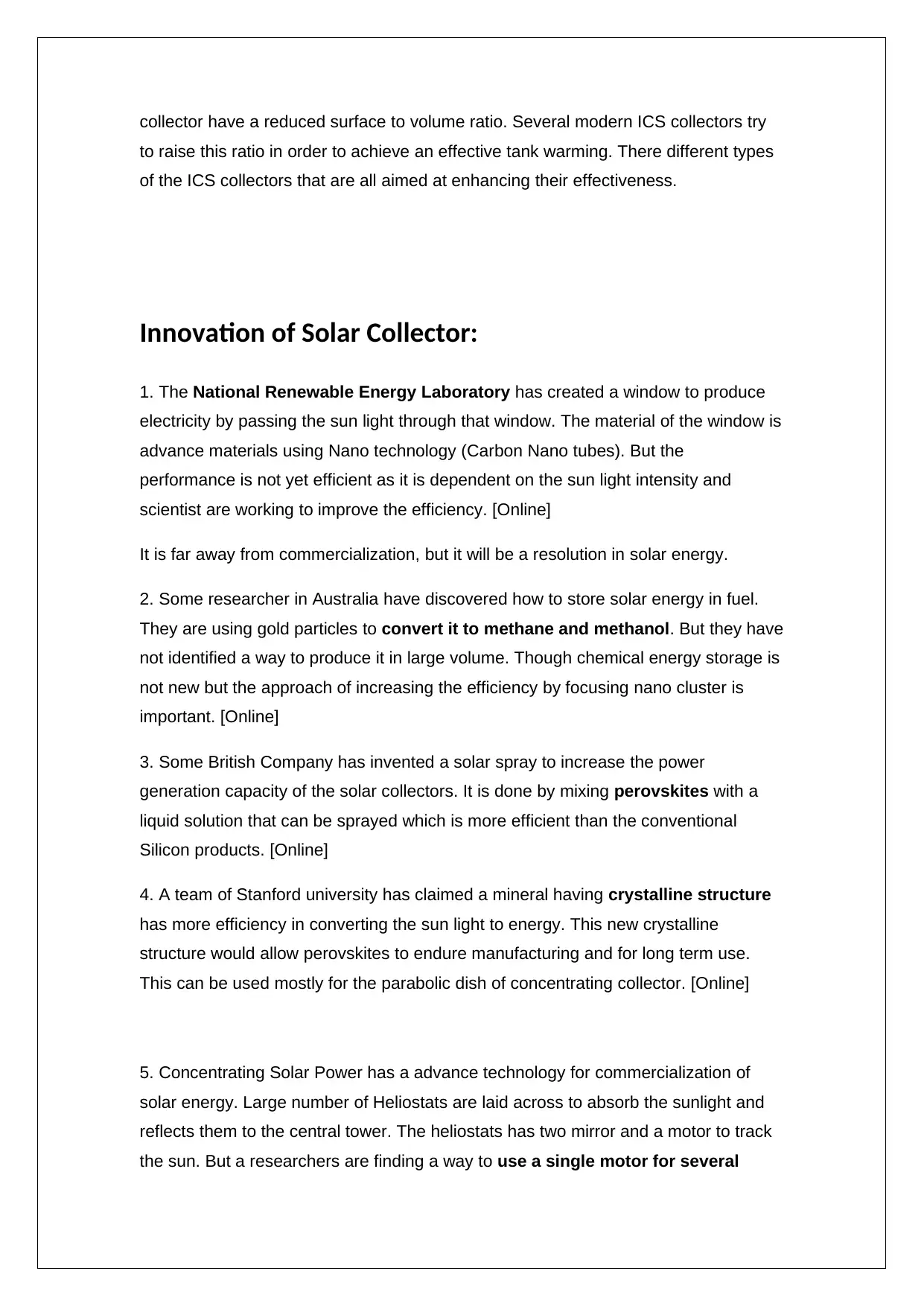
collector have a reduced surface to volume ratio. Several modern ICS collectors try
to raise this ratio in order to achieve an effective tank warming. There different types
of the ICS collectors that are all aimed at enhancing their effectiveness.
Innovation of Solar Collector:
1. The National Renewable Energy Laboratory has created a window to produce
electricity by passing the sun light through that window. The material of the window is
advance materials using Nano technology (Carbon Nano tubes). But the
performance is not yet efficient as it is dependent on the sun light intensity and
scientist are working to improve the efficiency. [Online]
It is far away from commercialization, but it will be a resolution in solar energy.
2. Some researcher in Australia have discovered how to store solar energy in fuel.
They are using gold particles to convert it to methane and methanol. But they have
not identified a way to produce it in large volume. Though chemical energy storage is
not new but the approach of increasing the efficiency by focusing nano cluster is
important. [Online]
3. Some British Company has invented a solar spray to increase the power
generation capacity of the solar collectors. It is done by mixing perovskites with a
liquid solution that can be sprayed which is more efficient than the conventional
Silicon products. [Online]
4. A team of Stanford university has claimed a mineral having crystalline structure
has more efficiency in converting the sun light to energy. This new crystalline
structure would allow perovskites to endure manufacturing and for long term use.
This can be used mostly for the parabolic dish of concentrating collector. [Online]
5. Concentrating Solar Power has a advance technology for commercialization of
solar energy. Large number of Heliostats are laid across to absorb the sunlight and
reflects them to the central tower. The heliostats has two mirror and a motor to track
the sun. But a researchers are finding a way to use a single motor for several
to raise this ratio in order to achieve an effective tank warming. There different types
of the ICS collectors that are all aimed at enhancing their effectiveness.
Innovation of Solar Collector:
1. The National Renewable Energy Laboratory has created a window to produce
electricity by passing the sun light through that window. The material of the window is
advance materials using Nano technology (Carbon Nano tubes). But the
performance is not yet efficient as it is dependent on the sun light intensity and
scientist are working to improve the efficiency. [Online]
It is far away from commercialization, but it will be a resolution in solar energy.
2. Some researcher in Australia have discovered how to store solar energy in fuel.
They are using gold particles to convert it to methane and methanol. But they have
not identified a way to produce it in large volume. Though chemical energy storage is
not new but the approach of increasing the efficiency by focusing nano cluster is
important. [Online]
3. Some British Company has invented a solar spray to increase the power
generation capacity of the solar collectors. It is done by mixing perovskites with a
liquid solution that can be sprayed which is more efficient than the conventional
Silicon products. [Online]
4. A team of Stanford university has claimed a mineral having crystalline structure
has more efficiency in converting the sun light to energy. This new crystalline
structure would allow perovskites to endure manufacturing and for long term use.
This can be used mostly for the parabolic dish of concentrating collector. [Online]
5. Concentrating Solar Power has a advance technology for commercialization of
solar energy. Large number of Heliostats are laid across to absorb the sunlight and
reflects them to the central tower. The heliostats has two mirror and a motor to track
the sun. But a researchers are finding a way to use a single motor for several
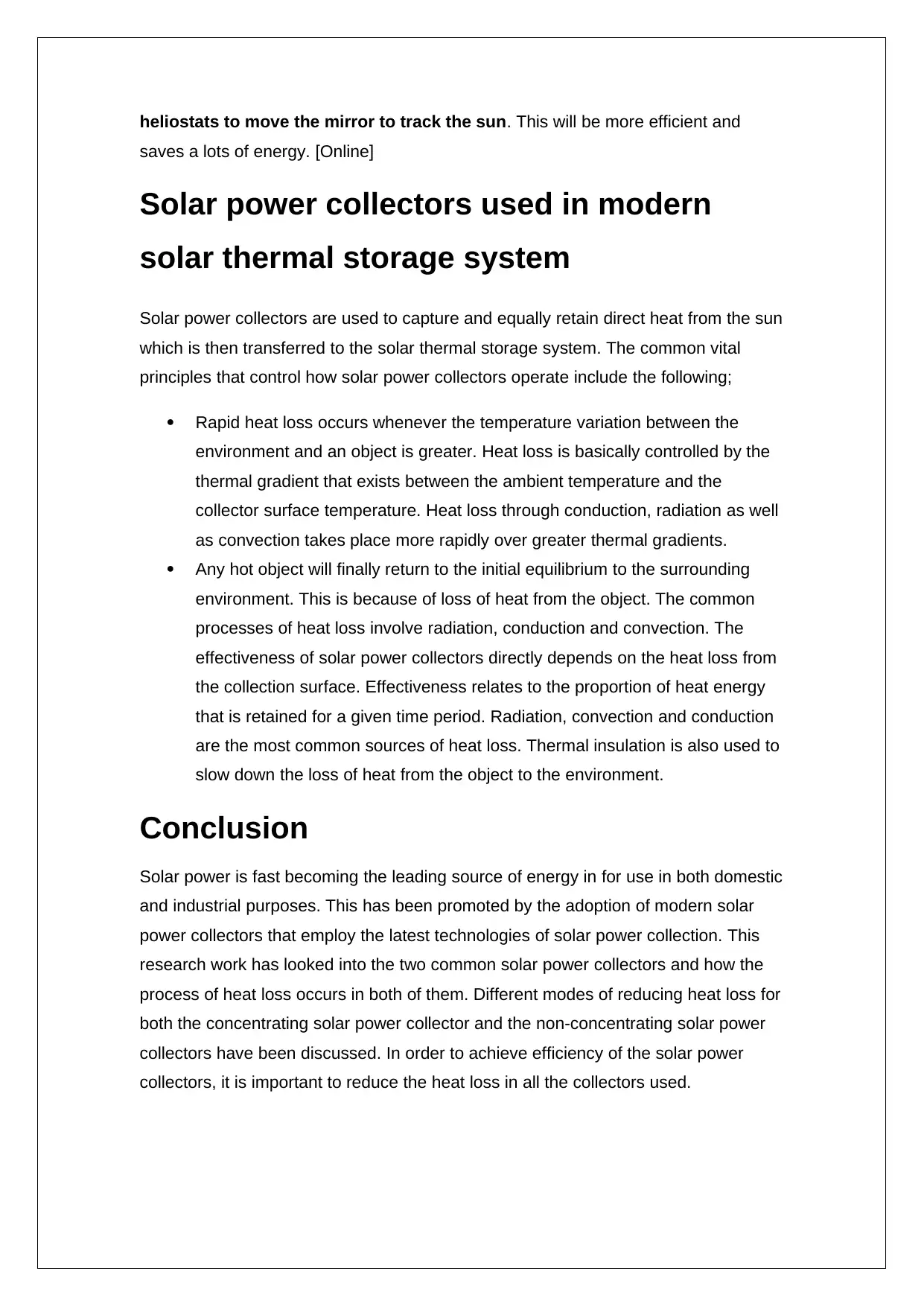
heliostats to move the mirror to track the sun. This will be more efficient and
saves a lots of energy. [Online]
Solar power collectors used in modern
solar thermal storage system
Solar power collectors are used to capture and equally retain direct heat from the sun
which is then transferred to the solar thermal storage system. The common vital
principles that control how solar power collectors operate include the following;
Rapid heat loss occurs whenever the temperature variation between the
environment and an object is greater. Heat loss is basically controlled by the
thermal gradient that exists between the ambient temperature and the
collector surface temperature. Heat loss through conduction, radiation as well
as convection takes place more rapidly over greater thermal gradients.
Any hot object will finally return to the initial equilibrium to the surrounding
environment. This is because of loss of heat from the object. The common
processes of heat loss involve radiation, conduction and convection. The
effectiveness of solar power collectors directly depends on the heat loss from
the collection surface. Effectiveness relates to the proportion of heat energy
that is retained for a given time period. Radiation, convection and conduction
are the most common sources of heat loss. Thermal insulation is also used to
slow down the loss of heat from the object to the environment.
Conclusion
Solar power is fast becoming the leading source of energy in for use in both domestic
and industrial purposes. This has been promoted by the adoption of modern solar
power collectors that employ the latest technologies of solar power collection. This
research work has looked into the two common solar power collectors and how the
process of heat loss occurs in both of them. Different modes of reducing heat loss for
both the concentrating solar power collector and the non-concentrating solar power
collectors have been discussed. In order to achieve efficiency of the solar power
collectors, it is important to reduce the heat loss in all the collectors used.
saves a lots of energy. [Online]
Solar power collectors used in modern
solar thermal storage system
Solar power collectors are used to capture and equally retain direct heat from the sun
which is then transferred to the solar thermal storage system. The common vital
principles that control how solar power collectors operate include the following;
Rapid heat loss occurs whenever the temperature variation between the
environment and an object is greater. Heat loss is basically controlled by the
thermal gradient that exists between the ambient temperature and the
collector surface temperature. Heat loss through conduction, radiation as well
as convection takes place more rapidly over greater thermal gradients.
Any hot object will finally return to the initial equilibrium to the surrounding
environment. This is because of loss of heat from the object. The common
processes of heat loss involve radiation, conduction and convection. The
effectiveness of solar power collectors directly depends on the heat loss from
the collection surface. Effectiveness relates to the proportion of heat energy
that is retained for a given time period. Radiation, convection and conduction
are the most common sources of heat loss. Thermal insulation is also used to
slow down the loss of heat from the object to the environment.
Conclusion
Solar power is fast becoming the leading source of energy in for use in both domestic
and industrial purposes. This has been promoted by the adoption of modern solar
power collectors that employ the latest technologies of solar power collection. This
research work has looked into the two common solar power collectors and how the
process of heat loss occurs in both of them. Different modes of reducing heat loss for
both the concentrating solar power collector and the non-concentrating solar power
collectors have been discussed. In order to achieve efficiency of the solar power
collectors, it is important to reduce the heat loss in all the collectors used.

Paraphrase This Document
Need a fresh take? Get an instant paraphrase of this document with our AI Paraphraser
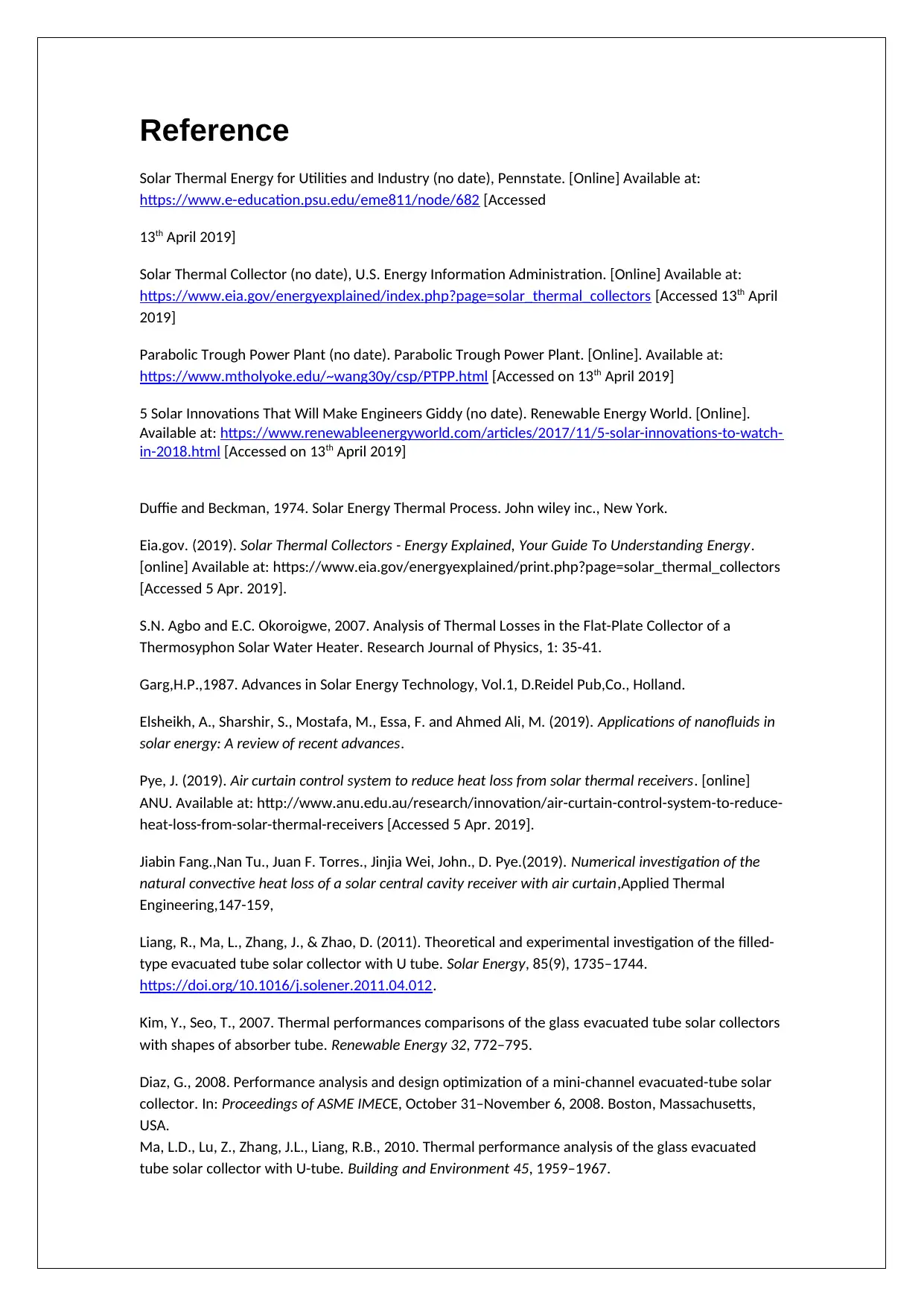
Reference
Solar Thermal Energy for Utilities and Industry (no date), Pennstate. [Online] Available at:
https://www.e-education.psu.edu/eme811/node/682 [Accessed
13th April 2019]
Solar Thermal Collector (no date), U.S. Energy Information Administration. [Online] Available at:
https://www.eia.gov/energyexplained/index.php?page=solar_thermal_collectors [Accessed 13th April
2019]
Parabolic Trough Power Plant (no date). Parabolic Trough Power Plant. [Online]. Available at:
https://www.mtholyoke.edu/~wang30y/csp/PTPP.html [Accessed on 13th April 2019]
5 Solar Innovations That Will Make Engineers Giddy (no date). Renewable Energy World. [Online].
Available at: https://www.renewableenergyworld.com/articles/2017/11/5-solar-innovations-to-watch-
in-2018.html [Accessed on 13th April 2019]
Duffie and Beckman, 1974. Solar Energy Thermal Process. John wiley inc., New York.
Eia.gov. (2019). Solar Thermal Collectors - Energy Explained, Your Guide To Understanding Energy.
[online] Available at: https://www.eia.gov/energyexplained/print.php?page=solar_thermal_collectors
[Accessed 5 Apr. 2019].
S.N. Agbo and E.C. Okoroigwe, 2007. Analysis of Thermal Losses in the Flat-Plate Collector of a
Thermosyphon Solar Water Heater. Research Journal of Physics, 1: 35-41.
Garg,H.P.,1987. Advances in Solar Energy Technology, Vol.1, D.Reidel Pub,Co., Holland.
Elsheikh, A., Sharshir, S., Mostafa, M., Essa, F. and Ahmed Ali, M. (2019). Applications of nanofluids in
solar energy: A review of recent advances.
Pye, J. (2019). Air curtain control system to reduce heat loss from solar thermal receivers. [online]
ANU. Available at: http://www.anu.edu.au/research/innovation/air-curtain-control-system-to-reduce-
heat-loss-from-solar-thermal-receivers [Accessed 5 Apr. 2019].
Jiabin Fang.,Nan Tu., Juan F. Torres., Jinjia Wei, John., D. Pye.(2019). Numerical investigation of the
natural convective heat loss of a solar central cavity receiver with air curtain,Applied Thermal
Engineering,147-159,
Liang, R., Ma, L., Zhang, J., & Zhao, D. (2011). Theoretical and experimental investigation of the filled-
type evacuated tube solar collector with U tube. Solar Energy, 85(9), 1735–1744.
https://doi.org/10.1016/j.solener.2011.04.012.
Kim, Y., Seo, T., 2007. Thermal performances comparisons of the glass evacuated tube solar collectors
with shapes of absorber tube. Renewable Energy 32, 772–795.
Diaz, G., 2008. Performance analysis and design optimization of a mini-channel evacuated-tube solar
collector. In: Proceedings of ASME IMECE, October 31–November 6, 2008. Boston, Massachusetts,
USA.
Ma, L.D., Lu, Z., Zhang, J.L., Liang, R.B., 2010. Thermal performance analysis of the glass evacuated
tube solar collector with U-tube. Building and Environment 45, 1959–1967.
Solar Thermal Energy for Utilities and Industry (no date), Pennstate. [Online] Available at:
https://www.e-education.psu.edu/eme811/node/682 [Accessed
13th April 2019]
Solar Thermal Collector (no date), U.S. Energy Information Administration. [Online] Available at:
https://www.eia.gov/energyexplained/index.php?page=solar_thermal_collectors [Accessed 13th April
2019]
Parabolic Trough Power Plant (no date). Parabolic Trough Power Plant. [Online]. Available at:
https://www.mtholyoke.edu/~wang30y/csp/PTPP.html [Accessed on 13th April 2019]
5 Solar Innovations That Will Make Engineers Giddy (no date). Renewable Energy World. [Online].
Available at: https://www.renewableenergyworld.com/articles/2017/11/5-solar-innovations-to-watch-
in-2018.html [Accessed on 13th April 2019]
Duffie and Beckman, 1974. Solar Energy Thermal Process. John wiley inc., New York.
Eia.gov. (2019). Solar Thermal Collectors - Energy Explained, Your Guide To Understanding Energy.
[online] Available at: https://www.eia.gov/energyexplained/print.php?page=solar_thermal_collectors
[Accessed 5 Apr. 2019].
S.N. Agbo and E.C. Okoroigwe, 2007. Analysis of Thermal Losses in the Flat-Plate Collector of a
Thermosyphon Solar Water Heater. Research Journal of Physics, 1: 35-41.
Garg,H.P.,1987. Advances in Solar Energy Technology, Vol.1, D.Reidel Pub,Co., Holland.
Elsheikh, A., Sharshir, S., Mostafa, M., Essa, F. and Ahmed Ali, M. (2019). Applications of nanofluids in
solar energy: A review of recent advances.
Pye, J. (2019). Air curtain control system to reduce heat loss from solar thermal receivers. [online]
ANU. Available at: http://www.anu.edu.au/research/innovation/air-curtain-control-system-to-reduce-
heat-loss-from-solar-thermal-receivers [Accessed 5 Apr. 2019].
Jiabin Fang.,Nan Tu., Juan F. Torres., Jinjia Wei, John., D. Pye.(2019). Numerical investigation of the
natural convective heat loss of a solar central cavity receiver with air curtain,Applied Thermal
Engineering,147-159,
Liang, R., Ma, L., Zhang, J., & Zhao, D. (2011). Theoretical and experimental investigation of the filled-
type evacuated tube solar collector with U tube. Solar Energy, 85(9), 1735–1744.
https://doi.org/10.1016/j.solener.2011.04.012.
Kim, Y., Seo, T., 2007. Thermal performances comparisons of the glass evacuated tube solar collectors
with shapes of absorber tube. Renewable Energy 32, 772–795.
Diaz, G., 2008. Performance analysis and design optimization of a mini-channel evacuated-tube solar
collector. In: Proceedings of ASME IMECE, October 31–November 6, 2008. Boston, Massachusetts,
USA.
Ma, L.D., Lu, Z., Zhang, J.L., Liang, R.B., 2010. Thermal performance analysis of the glass evacuated
tube solar collector with U-tube. Building and Environment 45, 1959–1967.

Chen Z, Gu M, Peng D, et al. A numerical study on heat transfer of high efficient solar flat-plate
collectors with energy storage[J]. International Journal of Green Energy, 2010, 7(3): 326-336.
Reddy K S. Thermal modeling of PCM-based solar integrated collector storage water heating
system[J]. Journal of solar energy engineering, 2007, 129(4): 458-464.
Jegadheeswaran S, Pohekar S D, Kousksou T. Performance enhancement of solar latent heat thermal
storage system with particle dispersion—an exergy approach[J]. CLEAN–Soil, Air, Water, 2011, 39(10):
964-971.
Nomura T, Akiyama T. High-temperature latent heat storage technology to utilize exergy of solar heat
and industrial exhaust heat[M]//Exergy for A Better Environment and Improved Sustainability 1.
Springer, Cham, 2018: 1207-1224.
collectors with energy storage[J]. International Journal of Green Energy, 2010, 7(3): 326-336.
Reddy K S. Thermal modeling of PCM-based solar integrated collector storage water heating
system[J]. Journal of solar energy engineering, 2007, 129(4): 458-464.
Jegadheeswaran S, Pohekar S D, Kousksou T. Performance enhancement of solar latent heat thermal
storage system with particle dispersion—an exergy approach[J]. CLEAN–Soil, Air, Water, 2011, 39(10):
964-971.
Nomura T, Akiyama T. High-temperature latent heat storage technology to utilize exergy of solar heat
and industrial exhaust heat[M]//Exergy for A Better Environment and Improved Sustainability 1.
Springer, Cham, 2018: 1207-1224.
1 out of 15
Related Documents
Your All-in-One AI-Powered Toolkit for Academic Success.
+13062052269
info@desklib.com
Available 24*7 on WhatsApp / Email
![[object Object]](/_next/static/media/star-bottom.7253800d.svg)
Unlock your academic potential
© 2024 | Zucol Services PVT LTD | All rights reserved.




